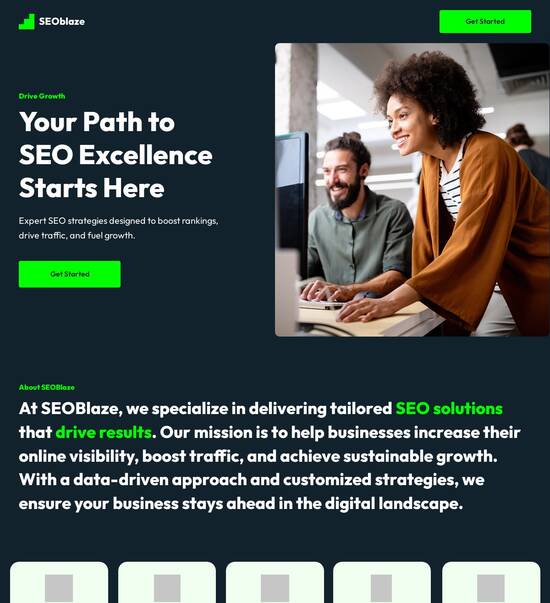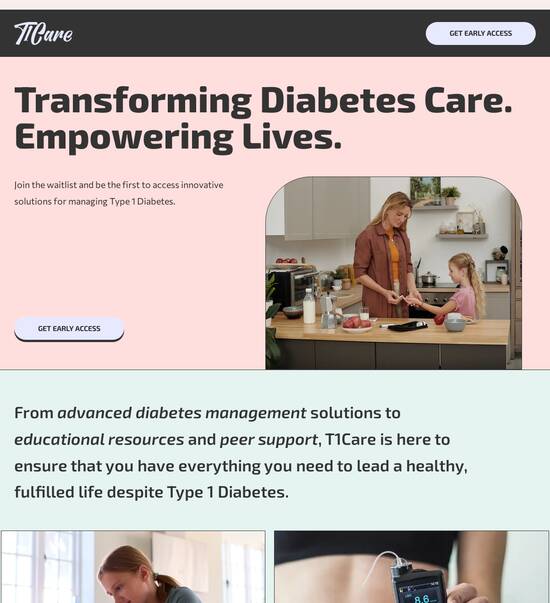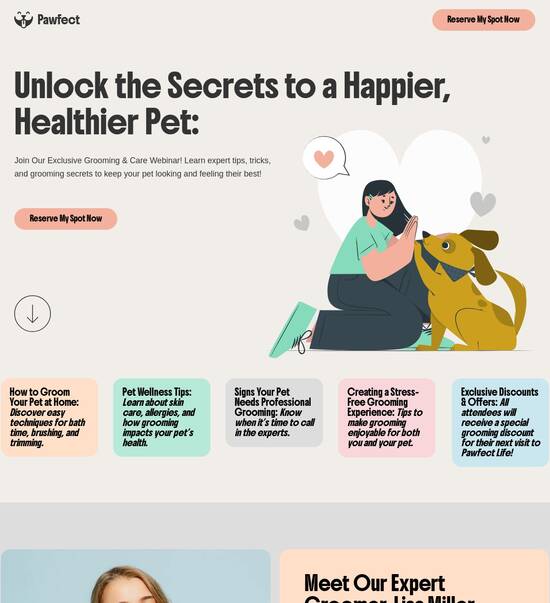
Angular.js optimized job portal template
Explore Similar TemplatesAbout template
Leverage our intuitive page builder and high-converting Angular.js optimized job portal template.
Recommended templates

Easy to build without coding
With the intuitive drag-and-drop builder, anyone on your team can create high-converting pages without any knowledge of code or design. Make enhancements to your landing page with custom widgets using Javascript, HTML/CSS, or third-party scripts.

Multiple layouts for any industry and goal
Select from 500+ landing page layouts built to boost conversions across industry-specific scenarios. Customize them by adjusting fonts, adding images, and generating on-brand content with the AI assistant. Quickly scale with Instablocks® and Global Blocks that you can save, reuse, and update globally.

Loads fast and looks polished on any device
Every template is responsive, which means they present professionally on any device and load blazingly fast with our Thor Render Engine. You can also power them up with Google AMP technology to deliver an unparalleled mobile experience and drive higher conversions.

Robust analytics & experimentation
Get real-time updates and reporting across all your devices, showing the number of visitors, conversions, cost-per-visitor, and cost-per-lead. Launch AI-powered experiments, run A/B tests, and use heatmaps to analyze user behavior, then optimize your landing page to maximize conversions.







Easy to build without coding
With the intuitive drag-and-drop builder, anyone on your team can create high-converting pages without any knowledge of code or design. Make enhancements to your landing page with custom widgets using Javascript, HTML/CSS, or third-party scripts.
Multiple layouts for any industry and goal
Select from 500+ landing page layouts built to boost conversions across industry-specific scenarios. Customize them by adjusting fonts, adding images, and generating on-brand content with the AI assistant. Quickly scale with Instablocks® and Global Blocks that you can save, reuse, and update globally.
Loads fast and looks polished on any device
Every template is responsive, which means they present professionally on any device and load blazingly fast with our Thor Render Engine.
Robust analytics & experimentation
Get real-time updates and reporting across all your devices, showing the number of visitors, conversions, cost-per-visitor, and cost-per-lead. Launch AI-powered experiments, run A/B tests, and use heatmaps to analyze user behavior, then optimize your landing page to maximize conversions.
All the features you need to build lead-generating landing pages
Explore more featuresLearn how to build top-performing landing pages for any goal
FAQs
Leading the way in building high-performing landing pages





A step-by-step guide to maximizing ROI with instapage
When it comes to digital marketing, an effective landing page can significantly enhance your campaign results. Instapage provides a comprehensive solution for marketers in various industries, enabling them to accelerate their conversion rate optimization (CRO) strategies. This guide will walk you through the essential steps to leverage Instapage for optimal campaign performance.
Understanding the importance of landing pages
Landing pages serve as crucial touchpoints for potential customers, designed specifically to drive conversions. The right approach not only captures leads but also nurtures them through tailored experiences. With Instapage's user-friendly templates and features, marketers can create high-converting landing pages effortlessly.
- Identifying target audiences: Tailoring your landing pages to specific demographics improves engagement.
- Utilizing high-converting templates: Choose from over 100 templates designed to maximize conversions while minimizing design time.
- Incorporating lead generation elements: Use forms and integrations that connect directly with your marketing tools for seamless data collection.
Creating high-converting landing pages
To build effective landing pages on Instapage, follow this structured approach:
Step 1: Choose a suitable template and layout
Start by selecting a template that aligns with your campaign goals. Follow these steps:
- Select a template that resonates with your target audience's preferences.
- Customize layout elements using Instablocks for a unique, branded experience.
- Optimize for mobile responsiveness ensuring accessibility for all users.
Step 2: Optimize content for conversions
Content is key in convincing visitors to act. Focus on the following:
- Craft attention-grabbing headlines that communicate value quickly.
- Include strong calls-to-action that prompt immediate engagement.
- Utilize persuasive copy that addresses pain points and offers solutions.
By following these steps, you can effectively boost your landing page performance with Instapage. Continuous testing and optimization based on real data will further enhance results.
Ready to elevate your digital marketing campaigns? Start with Instapage today and transform your landing pages for maximum ROI.
Unveiling the AngularJS optimized job portal template: A comprehensive exploration
The evolution of hiring platforms: Setting the stage
Over the years, hiring platforms have transformed significantly from traditional recruitment methods like CV handouts and newspaper ads to advanced digital solutions. The rise of the internet has played a vital role in this shift, making it easier for companies to reach potential candidates and streamline their hiring processes through web applications. This evolution has emphasized efficiency, accessibility, and enhanced candidate experience.
Organizations have begun prioritizing digital hiring solutions, enabling better tracking of applications and providing extensive resources for both employers and job seekers. The agility of web applications, particularly those designed with AngularJS, offers a high level of effectiveness in recruitment practices, ensuring a smooth experience for users. Today, organizations can leverage various tools and technologies to meet their specific hiring goals and address the overarching expectations of prospective employees.
Understanding hiring goals
Establishing clear hiring goals is crucial for any effective hiring platform. Hiring objectives must align with organizational needs, reflecting the competencies required for various roles while also appealing to the expectations of candidates. Central to this alignment is understanding the skill sets that are in demand and establishing a framework for attracting top talent.
Further, the hiring process should be designed to create a positive candidate journey, encompassing clear communication and a streamlined application process. By defining hiring goals tailored to the company’s ethos and ensuring a candidate-centric approach, organizations can foster long-term relationships with top talent, supporting both organizational growth and employee satisfaction.
AngularJS: A robust framework for dynamic job portals
AngularJS stands out as a leading framework for building dynamic web applications, particularly job portals. Its architecture supports a modular approach, allowing developers to create interactive and responsive user interfaces that enhance the overall user experience. The key benefits of AngularJS include two-way data binding, which updates the view whenever the model changes and vice versa, and dependency injection that simplifies development and testing.
Two-way data binding: Ensures real-time updates between the model and view.
Dependency injection: Promotes code reusability and easier testing.
Modular structure: Facilitates organized, maintainable code with clear separation of concerns.
With these features, AngularJS empowers developers to create job portals that are not only visually appealing but also functional and efficient. The framework’s capability to handle extensive data and numerous user interactions allows for a seamless experience that can cater to both job seekers and employers.
Crafting impactful job applications: The role of templates
Templates are vital in standardizing job descriptions and ensuring clarity across listings. Well-defined templates can significantly improve the engagement of potential applicants, clearly communicating expectations and organizational values. Key elements of an effective job description template should include a compelling overview of the role, essential qualifications, and employee benefits.
Job title: Clear and concise to attract the right candidates.
Overview: A brief summary of the position and its significance in the organization.
Responsibilities: Detailed tasks and expectations from the candidate.
Qualifications: Required skills and experience to filter suitable candidates.
Company culture and benefits: An attractive portrayal of work environment and perks.
By integrating these key elements, organizations can create compelling job descriptions that not only attract high-quality candidates but also help establish a well-defined employer brand. Tailoring templates to cater to specific industries ensures relevancy and clarity, further increasing the likelihood of drawing the right talent.
Tailoring templates for diverse hiring needs
While the core components of effective job descriptions are essential, the versatility of templates allows for customization to fit different roles and industries. Organizations should be flexible and adapt their templates to target the unique requirements of each position, thus attracting suitable candidates. For example, a technology company may focus on innovative projects and cutting-edge technologies, while a non-profit organization may highlight community impact and mission-driven work.
Industry-specific keywords: Incorporating relevant terminology to resonate with potential candidates.
Variations in responsibilities: Tailoring tasks and functions based on role requirements.
Highlighting benefits: Showcasing distinct perks that set the company apart from competitors.
Organizations can also take advantage of performance metrics gathered over time to refine and enhance their templates. This data-driven approach enables continuous improvement of the recruitment process, fostering better alignment with evolving hiring demands and candidate expectations.
Streamlining the candidate journey with optimized user interfaces
User experience is a crucial element when developing job portals, as intuitive navigation can significantly enhance the candidate journey. With AngularJS, developers can create responsive interfaces that adapt seamlessly across devices, ensuring a consistent experience regardless of how candidates access the portal.
Intuitive navigation: Making it easy for candidates to find information.
Personalized dashboards: Allowing candidates to manage applications and track progress.
Responsive design: Ensuring usability across devices, from desktops to smartphones.
Incorporating user-centric design principles improves engagement and satisfaction, elevating the overall experience. Moreover, feedback loops can be integrated within the portal, allowing candidates to share their experiences and suggestions for improvement, fostering an environment of continuous enhancement.
Engagement strategies within the job portal
To enhance candidate interaction, job portals should incorporate various engagement strategies within their architecture. Features such as live chat, application progress tracking, and notifications for new job postings can greatly increase user satisfaction. These functionalities not only keep candidates informed but also encourage them to remain engaged throughout the hiring process.
Live chat support: Providing real-time assistance to candidates.
Application status updates: Keeping candidates informed about their application progress.
Job alerts: Alerting candidates to new positions matching their preferences.
By implementing these features, companies can create an inviting platform that resonates with candidates, leading to improved candidate satisfaction and a higher likelihood of successful placements.
Empowering employers: A toolkit for effective hiring
Providing employers with the right tools and functionalities is paramount in enhancing their experience using job portals. Features such as easy job listing management and analytics capabilities are essential for efficient hiring processes. Through AngularJS, developers can create dashboards where employers can effortlessly manage job postings, view candidate applications, and track hiring metrics.
Job listing management: Simplifying the process of posting and editing job openings.
Candidate tracking systems: Allowing employers to manage and filter candidates based on their applications.
Analytics and reporting: Providing insights into hiring effectiveness and candidate engagement.
Implementing such features empowers employers to take charge of their recruitment processes effectively, making data-driven decisions to optimize outcomes and enhance overall performance.
Integrating version control systems to manage changes
Maintaining accuracy in job descriptions is crucial, and integrating version control systems can significantly streamline this process. Version control allows employers to track changes made to job listings over time, ensuring consistency while easing management of multiple job postings. This approach not only improves the clarity of job descriptions but also aids in minimizing potential legal issues related to outdated or inaccurate postings.
Continuous updating: Ensuring job descriptions remain relevant and accurate.
Clear audit trails: Keeping records of changes for accountability.
Easy rollbacks: Allowing employers to revert to previous versions if needed.
By adhering to best practices for implementing version control, organizations can improve the overall quality and accuracy of job descriptions, safeguarding both company reputation and candidate confidence.
Bridging the gap: Connecting candidates and companies
Enhanced search capabilities are vital in ensuring candidates can easily find the right job listings. Implementing smart search features that utilize filters and sorting based on key criteria can significantly improve the matching process between candidates and employers. The ability to narrow searches based on location, industry, or job type enables candidates to efficiently navigate the job portal.
Keywords search: Allowing candidates to enter terms that relate to their desired job.
Filtering options: Providing criteria such as experience level, job type, and salary range.
Sorting results: Enabling candidates to sort by date posted, relevance, or salary.
Furthermore, creating a responsive candidate dashboard fosters better communication between candidates and employers. Candidates should have opportunities to customize their profiles for improved visibility, allowing employers to connect with them more easily based on their specific qualifications.
Creating a responsive candidate dashboard
Incorporating features that facilitate candidate tracking and progress updates is essential in a job portal. A well-designed dashboard allows candidates to manage applications, save preferred job listings, and receive updates in real time. Simplifying this process improves user engagement, keeping candidates invested in their job search efforts.
Application management: Enabling candidates to view their submitted applications easily.
Profile customization: Allowing candidates to highlight their skills and experiences.
Notifications for updates: Keeping candidates informed of any changes to their applications or new job postings.
By enhancing the candidate dashboard, organizations can foster a more interactive and engaging environment, ultimately benefiting the overall recruitment process and enhancing user satisfaction.
Innovative solutions to common hiring challenges
Common challenges faced by both companies and candidates include miscommunication, inefficient application processes, and lack of engagement. An AngularJS optimized job portal effectively addresses these issues through its robust architecture, which supports streamlined workflows and improved interaction between users. The real-time data processing capabilities, along with user-friendly design, significantly minimize barriers in the hiring process.
Enhanced communication: Facilitating better interactions through integrated messaging systems.
Efficient application workflows: Streamlining submission processes to reduce candidate frustration.
Data-driven insights: Utilizing analytics to improve recruitment strategies.
By tackling these common pain points, organizations can create more effective hiring platforms and improve the overall experience for both candidates and employers.
Real-life case studies: Success stories using AngularJS templates
Several organizations have successfully implemented AngularJS optimized job portals, leading to measurable outcomes in their hiring processes. From tech startups to large corporations, the adaptability and performance of AngularJS frameworks have allowed businesses to meet their recruitment goals. Case studies demonstrate increased candidate satisfaction, improved application processing times, and enhanced employer engagement.
Company A: Reduced application processing time by 30% after integrating an AngularJS template.
Company B: Improved candidate satisfaction rates by 40% through a more interactive user experience.
Company C: Successfully attracted 25% more applicants after revamping their job portal.
These success stories solidify the importance of investing in optimized job portal templates, demonstrating that a well-structured platform can significantly enhance the hiring process for all parties involved.
Future trends in job portals using AngularJS
The recruitment landscape is constantly evolving, with technology at the forefront of these changes. As companies continue to leverage AngularJS for their job portals, we can expect new functionalities to emerge that further optimize the hiring process. Anticipating future trends, such as enhanced AI integration and advanced analytics capabilities, will likely shape the next generation of job portals tailored to meet diverse hiring needs.
AI-powered candidate matching: Utilizing algorithms to enhance candidate-job matching efficiency.
Predictive analytics: Analyzing recruiting data to forecast hiring needs and trends.
Incorporating blockchain technology: Securing candidate information and enhancing transparency.
These innovations are poised to redefine how organizations engage with candidates, creating even more efficient and appealing hiring ecosystems. As businesses adapt to these trends, the significance of well-optimized job portals powered by AngularJS will only continue to grow.
Conclusion: The transformative power of AngularJS in job portals
The importance of optimized templates cannot be overstated when it comes to building effective job portals. They serve as the foundation for engaging candidate experiences and enable organizations to streamline their hiring processes. The flexibility and features offered by AngularJS make it an ideal choice for developing job portals that meet today's recruitment demands.
As hiring practices continue to evolve, leveraging the capabilities of AngularJS will empower organizations to create impactful hiring platforms that foster better relationships between candidates and employers. The future of job portals lies in their ability to merge technology with user-centric approaches, producing hiring solutions that enhance efficiency, engagement, and satisfaction.
Ready to skyrocket conversions?
Supercharge your ad campaigns with high-performing landing pages
Get started














